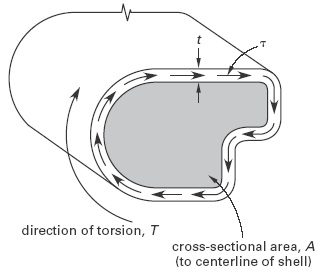Related Resources: calculators
Torsion in Thin-Walled Noncircular Shells Calculator
Torsion in Thin-Walled Noncircular Shells Formulas and Calculator
Shear stress due to torsion in a thin-walled, noncircular shell (also known as a closed box) acts around the perimeter of the shell, as shown in Fig. 1. The shear stress, (, is given by Eq. 1. A is the area enclosed by the centerline of the shell.
Preview: Torsion in Thin-Walled Shells Calculator
Eq. 1
τ = T / ( 2 · A · t )
Figure 1 Torsion in Thin-Walled Shells

The shear stress at any point is not proportional to the distance from the centroid of the cross section. Rather, the shear flow, q, around the shell is constant, regardless of whether the wall thickness is constant or variable.
The shear flow is the shear per-unit length of the centerline path.26 At any point where the shell thickness is t,
Eq. 2
q = τ · t = T / ( 2 · A )
When the wall thickness, t, is constant, the angular twist depends on the perimeter, p, of the shell as measured along the centerline of the shell wall.
Eq. 3
γ = T · L · p / ( 4 · A2 · t · G )
Where:
τ = shear stress, lb/in2, N/m2
t = wall thickness, in, m
T = torque, in-lbf, m-N
A = section area, in2, m2
L = length, in, m
p = perimeter as measured from centerline, in, m
G = shear modulus, lb/in2, N/m2
γ = angle of twist, radian
q =
shear flow lbf/in, N/m
The concept of shear flow can also be applied to a regular beam in bending, although there is little to be gained by doing so. Removing the dimension b in the general beam shear stress equation, q = VQ/I.
Reference
Civil Engineering Reference Manual, Fifteenth Edition, Michael R. Lindeburg, PE
Related
- Shear Modulus of Rigidity Table of Engineering Materials
- Shear Center for Beams Equations and Calculator
- Shear Stress Equations and Applications
- Z-Section Flange Beam Intermediate Torsional Loading Equations and Calculator
- Torsional Deflection of Shaft
- Double Y Section with Concentrated Intermediate Torsional Loading Per. Roarks Formulas
- Twin Channel With Flanges Outward Intermediate Torsional Applied No 5 Per. Roarks Formulas
- Torsional Rigidity Solid Shaft vs Hollow Shaft Formulas and Calculator
- Hat Section Intermediate Torsion Applied No 3 Roarks Formulas for Stress and Strain Equations and Calculator
- Torsion Spring Force Calculator and Formula
- Diameter Combined Torsion and Bending Equation and Calculator
- Shaft Torsional Deflection and Rigidity Formulae and Calculator